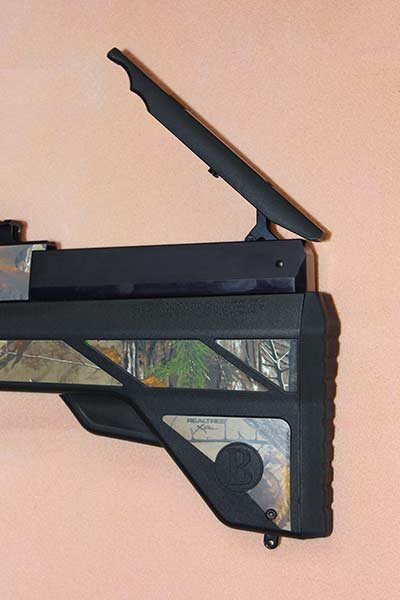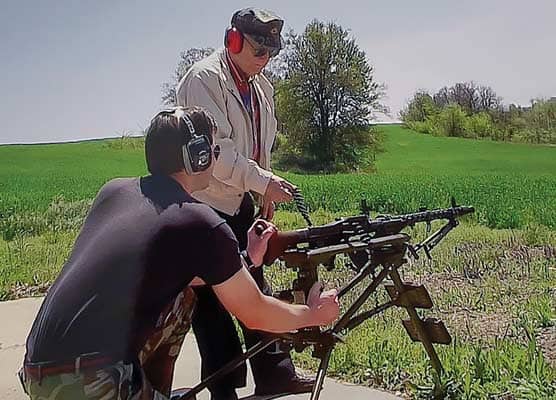New-Age Game-Getter
Part Crossbow, Part Airgun, Crosman’s Benjamin Pioneer
Airbow May Be the Last Word in Air Power
The ancient art of shooting arrows was given a contemporary blast of air when Crosman introduced the Benjamin Pioneer Airbow in
January 2016.
A video showing hunting icon Jim Shockey dropping a 2,000-lb. bison with one quickly went viral. While interest was high, some critics disseminated misinformation concerning the Airbow’s performance and legality.
The truth was, Crosman had created a new class of hunting weapon. But what was it exactly? And what could it do?
What It Is
The Pioneer Airbow is a .35 caliber pre-charged pneumatic (PCP) airgun that shoots full-length 375-gr.arrows — not crossbow bolts as was widely reported. Based on the Benjamin Bulldog .357 caliber big-bore air rifle, the bullpup configuration is not particularly elegant, but the adaptation from shooting slugs to shooting arrows is remarkable.
Gone is the chamber and so is most of the barrel — shortened to just a nub — then fitted with a stainless steel tube. This functions as a guide rod (renamed “arrow rest”) for 26″ carbon arrows that slide over the full length of the 25″ rod. Arrows are seated with manual pressure to what remains of the .357 caliber barrel, courtesy of a special metal collar where the nock should be.
A longer tubular air reservoir with an air regulator, a repositioned pressure gauge and a repositioned cocking lever — from right side to top of stock — complete the “Bulldog to Airbow” makeover … not unlike the transformation of frog to prince after the princess’ kiss.
Finally, like crossbows and other airguns for hunting, the Airbow is a limited-range weapon.
What It’s Not
First off, the Pioneer Airbow is not a bow by any definition. There’s no string, no limbs, no bow. Last July, the ATA acknowledged the Airbow as “an innovative piece of shooting equipment” lacking the basic components of standard archery equipment.
However, Crosman insisted on the Airbow moniker in support of their strategy for targeting the crossbow market. To date, several states have recognized the Airbow as the functional equivalent of the crossbow. No state, however, has accepted it for use in archery-only restricted hunting seasons, and Crosman has not promoted it as such.
The Pioneer Airbow is not silent. Big-bore airguns release a large volume of air with each shot, and many are loud enough to damage hearing. Despite a sound dampening design, the Airbow is loud enough to require the use of hearing protection. And the claim Crosman has created the “ultimate poacher’s weapon” is entirely unfounded, considering its loud report and limited range. Other weapons are quieter, have greater lethal range and are a lot less expensive ($999 MSRP) than the Airbow.
How It Works
The onboard air reservoir is charged to a maximum pressure of 3,000 psi through an exposed filling port. A quick-connect nipple is supplied for attachment to a hand pump or high-pressure charging system like a scuba tank.
The Airbow is loaded by sliding an arrow over the rest tube and seating it manually on the barrel inside the protective shroud. Cock it by lifting the ambidextrous lever mounted on top of the stock (which requires only 2 lbs. of force), release the trigger safety, aim and shoot. Follow-up shots require only a few seconds.
Decocking and unloading is just as easy. Lift the cocking lever and hold it in place while pulling the trigger, then remove the arrow from the rest. Unlike a crossbow, you don’t have to fire expensive arrows and broadheads into the ground to unload the weapon.
In the words of friend-gunsmith Shane Clark during our first predator hunt with the Airbow, “This is just too easy.”
Performance Plus!
Crosman claims the Pioneer Airbow will shoot 2-inch groups at 50 yards, which is comparable to the .357 Bulldog shooting 145-gr. slugs. I can personally attest this claim is modestly understated, as I routinely put arrows into the same hole at 50 yards, even with broadheads. The third shot I ever took with the Airbow was a near “Robin Hood” at 25 yards, as the field point of arrow No. 3 struck the collar of arrow No. 2 buried deep in the target.
Since arrows are essentially pulled from the front by air rather than pushed from the rear by a string, there is no arrow shaft oscillation. The arrow rest fits precisely inside the hollow carbon arrow shaft, and this tube delivers the air charge right behind the broadhead or field point. When a 26″ arrow leaves this 25″ long rest, it is already flying about as true as an arrow can.
Factor in a good 2-stage trigger and no recoil — plus consistent velocity by virtue of the internal pressure regulator — and remarkably consistent point of impact is the result.
Penetration is impressive. Arrows routinely pass through most block-type archery targets, and high hits often knocked free-standing targets over.
How It Handles
Although it may look awkward, the compact Airbow points quickly and is easy to hold steady on target, whether freehand or rested. A 6x40mm CenterPoint scope with custom MTAG reticle and a canted Weaver base are included in the package. With a 30-yard zero, each horizontal hash mark on the vertical axis corresponds to 5 yards. Thus, the fourth hash mark down from center puts the arrow on target at 50 yards. Taking varmints and small predators with arrows requires precise shot placement and the Airbow is up to the task.
To date, I have spent more than 100 hours in the field with the Pioneer, taking several foxes and coyotes, as well as difficult-to-hit prairie dogs. The large-diameter arrows are wind-sensitive, however, and windage hash marks on the horizontal axis of the scope reticle are useful when conditions warrant hold-off.
Accuracy and terminal energy generated by the Airbow will allow hunters to push the effective range for larger animals like deer and hogs beyond 70 yards, as hitting a paper plate-sized target consistently at 100 yards is no problem when winds are calm.
Crossbow Comparison
Although it’s a pneumatic weapon, the Airbow functions like a crossbow in that it’s shoulder-fired and releases an arrow with the pull of a trigger. It fires up to eight arrows on a full air charge at a blistering 450 fps and velocity remains consistent due to the internal pressure regulator. Some premium crossbows are advertised at 400 fps, but few actually achieve it. Much higher velocities are possible with Airbow technology, but arrows are subsequently destroyed.
The Airbow generates up to 168 foot-pounds of energy shooting the 375-gr. Victory ICE arrows, with an applied force of 150 lbs. (Ibf) over a 25″ power stroke. This compares favorably with premium crossbows that fire shorter bolts typically slower than 400 fps, generating up to 110 FPE from 150-180 lbf over a 16″ power stroke. The Airbow is 33.5″ long and weighs 7 lbs., while most crossbows are a little longer and heavier.
Safety is unquestionably one of the best features of the Airbow. Its compact profile and ambidextrous top-mounted cocking lever requiring only 2 lbs. of force means virtually anyone can handle it. With no cocking rope to lose or tangle, and no limbs or string to potentially interfere with the shooter, the Airbow is arguably safer to use than a crossbow. Although it can be dry-fired without damage, decocking without firing is easy. These features make it particularly well-suited for both disabled hunters, and those with physical limitations precluding crossbow use. This factor could possibly be the Airbow’s greatest source of appeal.
Where It’s Legal
Generally, the Airbow is legal for hunting where .35 caliber pre-charged pneumatic (PCP) airguns are legal and the projectile is not defined.
Alabama, Arizona, California, Maryland, Missouri, North and South Carolina, and Washington are states leading the way with hunting opportunities for large and small game. About 30 states allow hunting for varmints like coyotes with airguns, 10 of these include feral hogs and five include deer.
Because the Airbow is a pneumatic weapon functioning like a crossbow, several states like Virginia and Wyoming are currently considering classifying them as crossbow alternatives. It’s always best to check with authorities as regulations vary considerably from state to state, and legality often hinges on specific wording regardless of regulatory intent. Crosman provides information about legality on their website and tools to guide hunters through the process of gaining regulatory approval.
Enthusiasm for the Pioneer Airbow among rifle and crossbow hunters remains high — among archery hunters, not so much. Some have expressed concern it will affect their deer seasons, and hardcore traditional bowhunters typically reject them — in much the same way they resented the encroachment of compound bows and then crossbows. But time marches on, and new technology has unquestionably facilitated growth in the hunting industry — a good thing for all who hunt, traditional or modern. In short, the Benjamin Pioneer Airbow is a remarkable hunting tool — and a lot of fun to shoot.
For More Info: www.crosman.com












